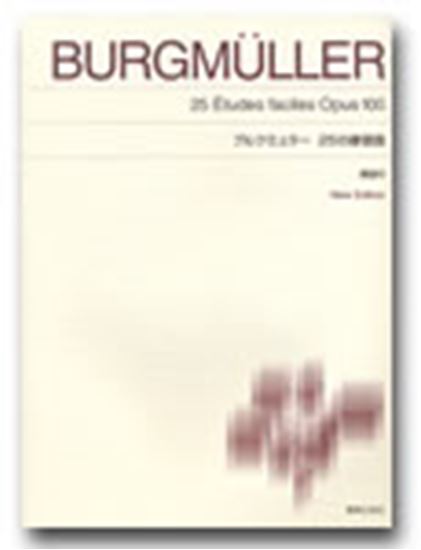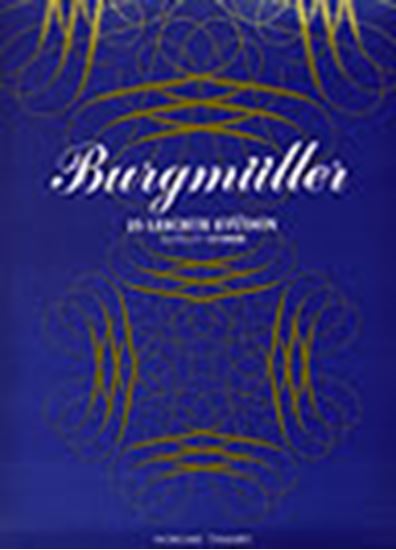Burgmüller, Johann Friedrich Franz : 25 Etudes faciles et progressives, conposées et doigtées expressément pour l'étendue des petites mains La candeur Op.100-1
Work Overview
Genre:etude
Total Playing Time:1 min 20 sec
Copyright:Public Domain
Additional Notes:表記ゆれの例: 素直な心 正直 素直 素直に あどけなさ
Commentary (3)
Author : Sato, Takashi
Last Updated: January 31, 2022
[Open]
Author : Sato, Takashi
A refreshing piece that opens the collection. It is well-known even outside of piano learners, as it is used for train departure bells, among other things. There are three harmonic points of interest: the strong sense of progression from the dominant of the dominant ("Doppeldominant"), borrowed from the dominant key (G major) (m. 7); the liberating feeling of the second inversion of the tonic chord ("six-four chord") following a diminished seventh chord (m. 14); and the melancholic expression of the Neapolitan chord (m. 17, 19), which appears towards the end of the piece and uses the A-flat from the parallel minor (C minor). The first two (m. 7, 14) are emphasized by appoggiaturas (non-harmonic tones on strong beats) in the right hand.
Performance Points (Original tempo: ♩ = 152)
This is an exercise in playing the eighth-note melody legato. Smoothly shift the weight from 5 - 3 - 2 - 1 -..., rotating the wrist slightly counter-clockwise (do not rotate too much). This allows for a smooth execution of the octave leap before measure 2. Once the right hand is proficient, the piece is structured to gradually challenge more difficult tasks, such as playing with the left hand from measure 9, and performing the same movement while holding the 5th finger in measure 13.
(From To-on Edition "Burgmüller 25 Etudes" (NS70))
Author : Ooi, Kazurou
Last Updated: January 31, 2019
[Open]
Author : Ooi, Kazurou
Performance Tips
While there are indeed various ways to play this piece, the author would like to offer some performance tips based on personal discretion and preference. Looking at the score as a whole, in addition to the Allegro Moderato tempo, whole notes are arranged in the left hand, serving as accompaniment. This is a tendency towards what is known as homophony. Since the melody in the right hand always has notes on the beat, it tends to emphasize the beat, resulting in a vertically-oriented musical texture. While such an interpretation is certainly valid, the author believes this music ought to flow horizontally. What techniques are necessary to achieve this horizontal flow?
Achieving Horizontal Flow
- Play the whole notes and half notes in the left-hand accompaniment as softly as possible. Imagine the left-hand three-note chords as three voices, played by cellos or violas. In that case, a strong attack on the first beat is not necessary, is it? To ensure a continuous, horizontal flow without breaks, the pedal is essential. The pedal eliminates the breaks between chords. Further details regarding pedaling will be discussed later.
- It is essential to play the right-hand melody line legato. To avoid any harsh, protruding notes, allow it to flow gently and horizontally.
Pedaling Techniques
Now, then, we use the pedal to make the music flow horizontally, but how should it be applied? With the exception of measures 1-2 and the final measure, every measure in this piece contains chromatic progression. This means that continuous pedaling will result in muddiness. As the author's advice, there are two ways to apply the pedal in this piece:
- One method is to depress the pedal only during beats 3-4 of each measure (with exceptions, of course), and to omit the pedal during beats 1-2. By depressing the pedal for beats 3-4 and releasing it on the first beat of the next measure, the left-hand chords can be connected smoothly.
- The other method is to depress the pedal in two-beat units. Either method is acceptable, and they can be used interchangeably depending on the specific passage.
Even when applying the pedal using these methods (depressing it for at least two beats), muddiness cannot be entirely avoided. While there are ways to completely avoid muddiness, the author intentionally recommends the aforementioned pedaling, which allows for a slight, deliberate muddiness. The muddiness created by the chromatic progression can evoke a truly romantic beauty. While avoiding muddiness perfectly, 'like splitting bamboo,' could be said to depict the title, the author feels that such a performance would become too dry and uninspired.
By playing dolce and pp, utilizing the aforementioned pedaling, and applying ample rubato, the piece transforms into something entirely different.
For your reference.
Author : Iida, Arisa
Last Updated: March 15, 2018
[Open]
Author : Iida, Arisa
Musical example provided by: Ongaku no Tomo Sha
PTNA & Partner Channel Videos(20items) View More
Sheet MusicView More
Scores List (25)

(株)東音企画(バスティン)

(株)東音企画(バスティン)

(株)東音企画(バスティン)

(株)全音楽譜出版社

(株)ドレミ楽譜出版社

(株)音楽之友社

KMP(ケイ・エム・ピー) ケイエムピー

(株)ドレミ楽譜出版社

ハンナ(ショパン)

(株)ヤマハミュージックエンタテインメントホールディングス

デプロMP

(株)ドレミ楽譜出版社

(株)全音楽譜出版社

(株)ドレミ楽譜出版社

カワイ出版

カワイ出版

デプロMP

(株)ヤマハミュージックエンタテインメントホールディングス

デプロMP

(株)ドレミ楽譜出版社

(株)音楽之友社

(株)共同音楽出版社

Neil A. Kjos Music Company



















